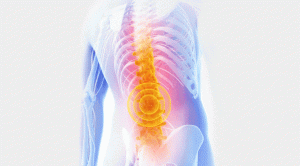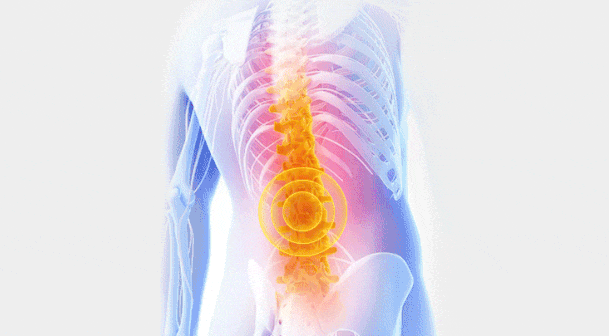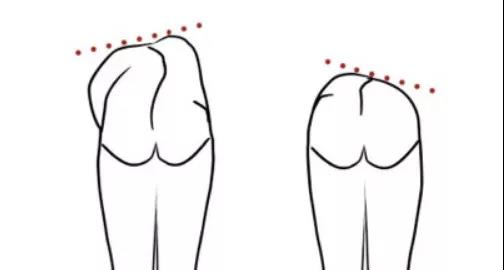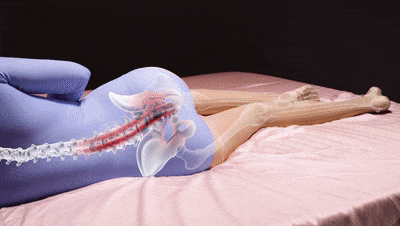
The sleeping position is wrong, the spine may be more and more “curved”
The spine is like a highly precise instrument, the error of the connection is not more than 1 mm, even a slight flash may cause damage to it.
How does the spine slowly hurt under the wrong sleeping position?
Lying on the side in a fixed posture for a long time is equivalent to keeping the pelvis always on the “side” and the lumbar spine will rotate accordingly.
Lying on the side
The shoulders, chest and pelvis are in contact with the surface of the bed, and the contact area is smaller than lying flat, but the pressure is increased.
Due to the gravitational action of the abdominal organs, the spine bends downward, so that the upper part of the spine is compressed and the lower part is stretched.
Lying flat
At this time, the pelvis is parallel to the shoulders and the spine is also in a straight state, which is the posture with the least burden on the waist.
The doctor suggested that when you fall asleep, you should follow the principle of “sleeping on your back first, and sleeping on your side as a supplement”; in order to avoid low back pain, you can choose to lie flat.
One action to see scoliosis
“Almost everyone will encounter spinal disease in their life.” Liu Haiying said, spinal disease is a process from quantitative to qualitative change, and 80% of spinal diseases are degenerative diseases.
In the beginning, it may just be that the joints are slightly misaligned, unbalanced, and distorted, which leads to abnormal stress on the spine; over time, organic diseases such as intervertebral disc herniation, spinal stenosis, and compression fractures will occur.

Under normal circumstances, the spine of a normal person begins to degenerate from the age of 25 on average, so middle-aged and elderly people are at a high risk of spondylopathy.
There are many reasons for scoliosis. In addition to the influence of long-term bad habits, it may also be secondary to various diseases. The following action can help you make a preliminary judgment:

1. Stand with feet shoulder-width apart, arms drooping, and leaning forward.
2. The examiner examines the subject’s back from the rear to see if there are any asymmetric protrusions. The higher protrusion is the convex side of the side curve.
If you have scoliosis, you must go to the hospital in time.
How much pressure does the spine bear every day?
To prevent spinal disease, good living habits are the foundation. Compare the video below to see how much pressure does your spine take on your sitting and standing positions?
Comparison of the degree of force on the spine in different postures, which posture do you think is more comfortable?
When a person stands upright, the spine is stressed at 100%
150% of the force on the spine when standing leaning forward
When sitting, the spine is stressed by 140%
When sitting forward leaning, the spine exerts 185% force
When bending over to carry heavy objects, the spine is subjected to 220% force
When lying on the side, 75% of the spine is exerted
When lying flat, the spine is only 25% stressed
Therefore, lying flat is the most friendly posture to the spine.
Let every sleep fit the spine
If you are in good health and no disease, then the body feels comfortable, which is a good sleeping position.
However, if your health is affected by poor sleeping posture, you must make timely adjustments.
Lying on your back allows the spine to relax the most
In order to avoid low back pain, lying flat is the most suitable position.
Watching TV or reading a book on a soft sofa or bed may make you feel good about yourself, but if you focus on other things, you may not realize that your muscles are tense and your spine is injured.

2 pillows make the spine more comfortable
It’s best to prepare two pillows, one for the neck and one between the knees.
A pillow with a thin middle and high top and bottom sides (about 10 cm high) can provide enough support for the head and neck without being too high.
When lying on your back, straighten your legs and place a pillow on the bend of your legs to keep a certain degree of curvature;
When lying on your side, it is best to bend your legs slightly and put a small pillow between your legs to keep your spine and head in a straight line.
Don’t choose a mattress that is too soft
Compared with a soft bed, a harder mattress can fully ensure the recovery of body curvature during sleep.
Grasp the hardness of the mattress and remember the “3:1 principle”: the mattress cannot be hard enough not to deform, nor too deformed.
A 3 cm thick mattress will sink 1 cm under hand pressure; a 10 cm thick mattress will sink 3 cm, so the ratio of softness to hardness is moderate.
Change “directions” often
No matter what sleeping position you use, you must remember to switch your posture frequently, especially if you are used to sleeping on the side, you can try to sleep on the side by turns to maintain a “balance” on both sides.
When resting in bed, you can also change positions from time to time. Simply turning over can relax your spine.
Comments